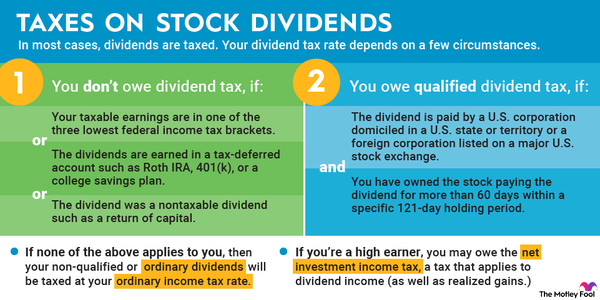Are Stock Dividends Taxable? Understand the Rules
 " width="250" height="250">
" width="250" height="250">Imagine this: you've been diligently investing in stocks, and finally, the day arrives when you receive your first dividend check. It's a moment of triumph, but before you start planning how to spend your newfound wealth, you might be wondering, "Are stock dividends taxable?" The answer isn't as straightforward as you might think, but don't worry—we're here to demystify the process for you.
What Are Stock Dividends?
Stock dividends are payments made by a corporation to its shareholders, typically from its profits. These payments can come in the form of cash or additional shares of stock. Understanding the tax implications of these dividends is crucial for maximizing your dividend income and minimizing your tax liability.
Types of Dividends
There are two primary types of dividends: qualified and non-qualified. Qualified dividends are taxed at the lower capital gains tax rate, while non-qualified dividends are taxed as ordinary income. The distinction between the two can significantly impact your tax brackets and overall financial strategy.
Qualified Dividends: The Golden Ticket
Qualified dividends are treated favorably by the tax code. To qualify, the dividends must meet specific holding period requirements. For common stock, you must hold the stock for more than 60 days during the 121-day period that begins 60 days before the ex-dividend date. For preferred stock, the holding period is more than 90 days during the 181-day period that begins 90 days before the ex-dividend date.
Why does this matter? Qualified dividends are taxed at the long-term capital gains tax rate, which is generally lower than the ordinary income tax rate. This can result in substantial savings, especially if you're in a higher tax bracket.
Non-Qualified Dividends: The Taxman Cometh
Non-qualified dividends, on the other hand, are taxed at your ordinary income tax rate. These dividends do not meet the holding period requirements and are treated as regular income. If you're in a higher tax bracket, this can significantly increase your tax liability.
Think of it like a race. Qualified dividends are like running a marathon—you have to put in the time and effort, but the reward is worth it. Non-qualified dividends are more like a sprint—quick and easy, but the payoff isn't as sweet.
Understanding Your Tax Brackets
Your tax brackets play a crucial role in determining how much you'll pay in taxes on your dividends. The U.S. has a progressive tax system, meaning the more you earn, the higher the tax rate. For qualified dividends, the rates range from 0% to 20%, depending on your income level. For non-qualified dividends, the rates can go as high as 37%.
It's essential to understand where you fall in the tax brackets to plan your investments effectively. For the most accurate and up-to-date information, you can refer to the IRS website.
Strategies to Minimize Tax Liability
So, how can you minimize your tax liability on dividends? Here are a few strategies to consider:
- Hold for the Long Term: Ensure your dividends qualify for the lower tax rate by holding your stocks for the required period.
- Diversify Your Portfolio: Spread your investments across different types of assets to balance your tax liability.
- Tax-Loss Harvesting: Offset your dividend income with losses from other investments.
- Use Tax-Advantaged Accounts: Invest in tax-advantaged accounts like IRAs or 401(k)s to defer or avoid taxes on your dividends.
Consulting a Professional
Navigating the complexities of dividend taxation can be challenging. Consulting with a financial advisor or tax professional can help you make informed decisions and optimize your investment strategy. They can provide personalized advice tailored to your unique financial situation and goals.
Conclusion
So, are stock dividends taxable? The answer is yes, but the extent to which they are taxed depends on various factors, including the type of dividend and your tax brackets. By understanding the rules and strategizing accordingly, you can maximize your dividend income and minimize your tax liability. Remember, knowledge is power, and being informed about dividend taxation can significantly impact your financial well-being.
Take the time to educate yourself, consult with professionals, and make informed decisions. Your future self will thank you for it. Now, go forth and invest wisely!
FAQs
1. What is the difference between qualified and non-qualified dividends?
Qualified dividends meet specific holding period requirements and are taxed at the lower capital gains tax rate. Non-qualified dividends do not meet these requirements and are taxed as ordinary income.
2. How do I know if my dividends are qualified?
To determine if your dividends are qualified, you need to check if you held the stock for the required period. For common stock, it's more than 60 days during the 121-day period before the ex-dividend date. For preferred stock, it's more than 90 days during the 181-day period.
3. Can I avoid paying taxes on dividends?
While you can't entirely avoid paying taxes on dividends, you can minimize your tax liability by holding stocks for the required period to qualify for the lower tax rate, diversifying your portfolio, and using tax-advantaged accounts.
4. What are the tax rates for qualified dividends?
The tax rates for qualified dividends range from 0% to 20%, depending on your income level and tax brackets. For the most accurate information, refer to the IRS website.
5. Should I consult a financial advisor for dividend taxation?
Consulting a financial advisor can be highly beneficial, especially if you have a complex financial situation. They can provide personalized advice and help you optimize your investment strategy to minimize tax liability.
```
Belum ada Komentar untuk " Are Stock Dividends Taxable? Understand the Rules"
Posting Komentar